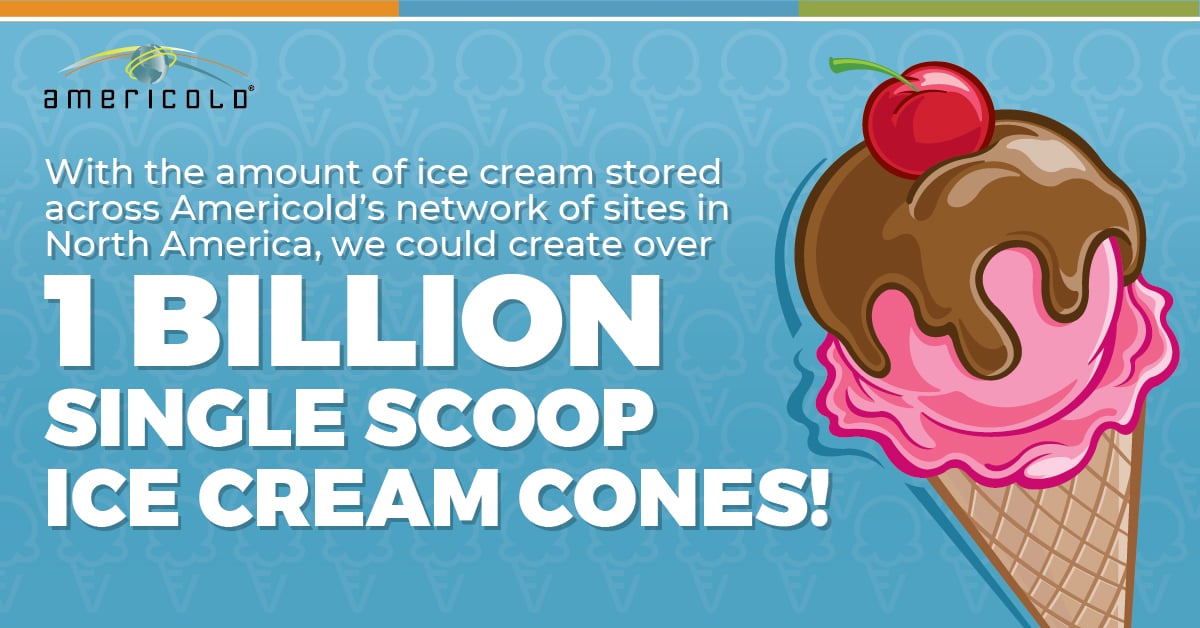Much like cook outs and county fairs, ice cream is a staple of summer. According to the International Dairy Foods Association, the United States produces more than 6.4 billion pounds of frozen dairy products annually[1] and Americans each consume around 20 pounds, or about 4 gallons, of ice cream each year.[2] As a trusted cold chain partner for frozen dairy treat producers around the world, we at Americold would like to explain how this sweet industry stays so cool.
Like most markets, the ice cream and frozen desserts market is segmented and regulated. With information from the Global Cold Chain Alliance (GCCA) and additional cited sources, here’s all you need to know:
Traditional ice cream comprises milk and/or cream, sugar, plus flavoring/mix-ins. The United States Food & Drug Administration (FDA) requires a minimum of 10% milkfat (which can come from milk or cream) for a product to be called ice cream. In addition, the United States Department of Agriculture (USDA) Standard for Ice Cream states in part, “Ice cream shall contain at least 1.6 pounds of total solids to the gallon, weigh not less than 4.5 pounds to the gallon, and contain not less than 20% total milk solids, constituted of not less than 10% milkfat.”[3] Commercially produced ice creams also contain FDA-approved stabilizers to control the growth of ice crystals during temperature fluctuations and emulsifiers to control smoothness and aid in whipping. Ingredients are blended, pasteurized, homogenized, and cooled, then packaged and blast or flash frozen to a recommended -20°F (- 29°C).
Additional product categories include: reduced fat ice cream, which is made with 25% less fat than either the average of leading brands or the company’s own brand; light ice cream, which is made with 50% less fat or 1/3 fewer calories than either the average of leading brands or the company’s own brand; low fat, which contains a maximum of 3 grams of total fat per serving; and non-fat, which contains less than 0.5 grams of total fat per serving. Further classification of super premium, premium, regular, and economy is based on quality factors detailed here. [4]
Products that do not meet the above stated requirements are often referred to as “frozen dairy desserts.”
Novelties are a subset of the ice cream market that comprise yogurt bars, ice cream sandwiches, sundae cones, popsicles, dessert cups, etc. The standard for these products are the same as the above, with the exception of yogurt-based products. Up and coming in the segment are plant-based ice creams. According to this 2019 report, the global dairy-free ice cream market was valued at $455.9 million in 2018 and is anticipated to reach $1.2 billion by 2025.
And all of these products need to be kept very cold so that you can enjoy their perfection.

Keeping things cool
As a trusted partner in the cold chain, Americold works closely with its ice cream and frozen dessert producer customers to ensure ideal conditions for all products while under our care between the point of production to the grocery store. The GCCA recommends ice cream and related products be stored at -18°F (-27.8°C) or colder, a preference that Americold ensures through implemented best practices and an unbroken cold chain.
Temperature tracking on trucks and in receiving areas, storage rooms, and sometimes even on individual pallets ensures all product moving through our facilities stays at the ideal temperature to keep product in top condition. Leveraging operational data, Americold also has the ability to pinpoint where in the cold chain temperatures need to be adjusted colder to compensate for variations that occur throughout product movement.
A sticky situation
If you’re a frequent ice cream eater, you know there’s nothing worse than opening the freezer, grabbing your favorite ice cream, and seeing it’s freezer burnt. What happened? Is the ice cream bad? How can you avoid this catastrophe in the future?
The good news: the ice cream is still perfectly fine. The explanation as to why it’s freezer burnt is quite scientific. When a product is frozen, its temperature decreases and some of the water in the product crystalizes. To minimize ice crystal growth, ice cream and frozen dessert producers use flash or blast freezing, a method that circulates very cold air over the product at a high velocity. More on that here. The shorter the freeze time, the smaller the ice crystals, which is one of the reasons why homemade ice cream tastes different. (It takes longer to freeze so has larger ice crystals.)
As commercially-produced frozen dairy products move through Americold’s cold chain they remain at or below -18°F (-27.8°C). At the grocery store, you remove the product from the freezer and put it in your cart. The product warms a bit until it’s placed in your at-home freezer, which is likely set at 0°F (-17.7°C).
The trip home, the higher temperature of your at-home freezer, plus frequent visits in and out of that freezer cause fluctuations in temperature of the product that promote ice crystal growth. The longer the product sits in your freezer, the higher the likelihood of ice crystals. Plus, product quality is a contributing factor. The higher the sugar content and/or milkfat percentage, the more likely it will develop freezer burn.
So, if you've ever needed an excuse to eat more ice cream, you now have one: you’re avoiding the risk of freezer burn!
Happy National Ice Cream Day – July 17th, 2022
[1] https://www.idfa.org/news-views/media-kits/ice-cream/the-history-of-ice-cream/?msclkid=2f06ee8dcf9f11ec85d2460a6ad54a16
[2] https://www.census.gov/newsroom/stories/ice-cream-day-month.html?msclkid=aeb4f987cfa011ec86750c68d8ad098a
[3] https://www.ams.usda.gov/grades-standards/ice-cream
[4] https://www.idfa.org/news-views/media-kits/ice-cream/ice-cream-labeling
Subscribe for Updates
Receive the latest news from Americold
